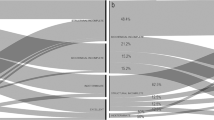Abstract
Purpose
During the follow-up of patients with well-differentiated thyroid carcinoma, some patients have elevated serum thyroglobulin (Tg) levels without any evidence of radioiodine accumulation on diagnostic whole-body scan (d-WBS). The treatment strategy in these patients is considered a clinical dilemma, with some groups recommending blind use of high-dose radioiodine therapy. The aim of this study was to evaluate whether or not high doses of radioiodine have beneficial effects in these patients.
Methods
Twenty-seven patients were included in the study. All patients had negative d-WBS and elevated levels of Tg. All received high doses of radioiodine. The mean follow-up period was 6.3±5.8 years. There were 11 patients with macrometastases and 16 with micrometastases.
Results
Post-treatment WBS revealed radioiodine accumulation in 19 of 24 (79%) patients. Serum Tg levels were decreased in 8 of 16 (50%) patients. Among patients with micrometastases, five out of seven (71%) demonstrated a decrease in serum Tg levels. Among patients with macrometastases, three out of nine (33%) demonstrated a decrease in Tg values and three (33%) have died due to metastatic thyroid cancer.
Conclusion
Radioiodine treatment may have a beneficial therapeutic effect in patients who have elevated levels of serum Tg and negative d-WBS. This is especially true in those patients with micrometastases; in patients with macrometastases, a beneficial effect of this approach may be observed less frequently.
Similar content being viewed by others

References
Atay-Rosenthal S. Controversies of treatment of well-differentiated thyroid carcinoma and factors influencing prognosis. In: Freeman LM, ed. Nuclear medicine annual. Philadelphia: Williams and Wilkins; 1999:3003–3334.
Mazzaferri EL, Kloos RT. Current approaches to primary therapy for papillary and follicular thyroid cancer. J Clin Endocrinol Metab 2001; 89:1447–1463.
Schlumberger M, Baudin E. Serum thyroglobulin determination in the follow-up of patients with differentiated thyroid carcinoma. Eur J Endocrinol 1998; 138:249–252.
Schulumberger M, Arcangioli O, Pierkarski JD, Tubiana M, Parmentier C. Detection and treatment of lung metastases of differentiated thyroid carcinoma in patients with normal chest x-rays. J Nucl Med 1988; 29:1790–1794.
Pineda JD, Lee T, Ain K, Reynolds JC, Robbins J. Iodine therapy for thyroid cancer patients with elevated thyroglobulin and negative diagnostic scan. J Clin Endocrinol Metab 1995; 80:1488–1492.
Pacini F, Agate L, Elisei R, Capezzone M, Ceccarelli C, Lippi F, Molinaro E, Pinchera A. Outcome of differentiated thyroid cancer with detectable serum Tg and negative diagnostic I-131 whole body scan: comparison of patients treated with high I-131 activities versus untreated patients. J Clin Endocrinol Metab 2001; 86:4092–4097.
Kabasakal L. Treatment of iodine negative, thyroglobulin positive, thyroid cancer patients: Do we miss the target when we shoot in the dark? Nucl Med Commun 2003; 24:739–741.
Fatourechi V, Hay ID, Javedan H, Wiseman GA, Mullan BP, Gorman CA. Lack of impact of radioiodine therapy in Tg-positive, diagnostic whole body scan-negative patients with follicular cell-derived thyroid cancer. J Clin Endocrinol Metab 2002; 87:1521–1526.
Waxman A, Ramanna L, Chapman N, et al. The significance of I-131 scan dose in patients with thyroid cancer: determination of ablation. J Nucl Med 1981; 22:861–865.
Sherman SI, Tielens ET, Sostre S, Wharam MD, Ladenson PW. Clinical utility of posttreatment radioiodine scans in the management of patients with thyroid carcinoma. J Clin Endocrinol Metab 1994; 78:629–634.
Pacini F, Lippi F, Formica N, Elisei R, Anelli S, Ceccarelli C, Pinchera A. Thrapeutic doses of iodine-131 reveal undiagnosed metastases in thyroid cancer patients with detectable serum thyroglobulin levels. J Nucl Med 1987; 28:1888–1891.
De Keizer B, Koppeschaar HPF, Zelissen PMJ, Lips CJM, Rijk PP, Dijk A, de Klerk JMH. Efficacy of high therapeutic doses of ioidine-131 in patients with differentiated thyroid cancer and detectable serum thyroglobulin. Eur J Nucl Med 2001; 28:198–202.
Mezzafferri EL. Treating high thyroglobulin with radioiodine: a magic bullet or a shot in the dark? J Clin Endocrinol Metab 1995; 80:1485–1487.
Fatourechi V, Hay ID. Treating the patient with differentiated thyroid cancer with thyroglobulin-positive iodine-131 diagnostic scan-negative metastases: including comments on the role of serum thyroglobulin monitoring in tumor surveillance. Semin Nucl Med 2000; 30:107–114.
Schlumberger M, challeton C, de Vathaire F, et al. Radioactive iodine treatment and external radiotherapy for lung and bone metastases from thyroid carcinoma. J Nucl Med 1996; 37:598–605.
Casara D, Rubello D, Saladini G, Masarotto G, Favero A, Girelli ME, Busnardo B. Different features of pulmonary metastases in differentiated thyroid cancer: natural history and multivariate statistical analysis of prognostic variables. J Nucl Med 1993; 34:1626–1631.
Sera N, Ashizawa K, Ando T, et al. Anaplastic changes associated with p53 gene mutation in differentiated thyroid carcinoma after insufficient radioactive iodine (I-131) therapy. Thyroid 2000; 10:975–979.
Schaap J, Eustatia-Rutten CFA, Stokkel M, Links TP, Diamant M, van der Velde EA, Romijn JA, Smit JWA. Does radioiodine therapy have disadvantageous effects in non-iodine accumulating differentiated thyroid carcinoma? Clin Endocrinol 2002; 57:117–124.
Helal BO, Merlet P, Tourbet ME, et al. Clinical impact of 18-F-FDG PET in thyroid carcinoma patients with elevated thyroglobulin levels and negative I-131 scanning results after therapy. J Nucl Med 2001; 42:1464–1469.
Sonmezoglu K, Kabasakal L, Ozmen O, Turkmen C, Onsel C, Bozluolcay S. Complementary role of FDG PET and Tc-99m MIBI scintigraphy in patients with differentiated thyroid cancer. Eur J Nucl Med 2003; 30:S279.
Schlumberger M, Mancusi F, Baudin E, Pacini F. I-131 therapy for elevated thyroglobulin levels. Thyroid 1997; 7:273–276.
Acknowledgement
This work was supported by the research fund of the University of Istanbul, project numbers BYP-151/15012003 and B-578/1702000.
Author information
Authors and Affiliations
Corresponding author
Rights and permissions
About this article
Cite this article
Kabasakal, L., Selçuk, N.A., Shafipour, H. et al. Treatment of iodine-negative thyroglobulin-positive thyroid cancer: differences in outcome in patients with macrometastases and patients with micrometastases. Eur J Nucl Med Mol Imaging 31, 1500–1504 (2004). https://doi.org/10.1007/s00259-004-1516-y
Received:
Accepted:
Published:
Issue Date:
DOI: https://doi.org/10.1007/s00259-004-1516-y



